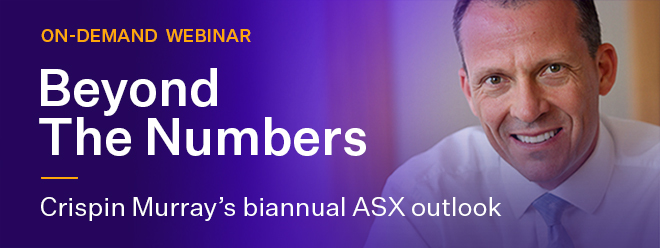
Mainstream Online Web Portal
LoginInvestors can view their accounts online via a secure web portal. After registering, you can access your account balances, periodical statements, tax statements, transaction histories and distribution statements / details.
Advisers will also have access to view their clients’ accounts online via the secure web portal.
Jim Taylor: What’s driving ASX stocks this week?
Here are the main factors driving the ASX this week according to portfolio manager JIM TAYLOR. Reported by investment specialist Jonathan Choong
- Find out about Pendal Focus Australian Share Fund
- On-demand: tune into Crispin Murray’s bi-annual Beyond the Numbers webinar
THE stock market fell for the third week in a row last week, as investors grappled with rising geopolitical tensions in the Middle East.
This overshadowed positive economic data that previously fuelled expectations of an interest rate cut by the US Federal Reserve.
Fed officials commented frequently throughout the week, but their remarks had little impact on those expectations, which are now firmly entrenched.
Bond yields rose across the board and the US dollar strengthened.
Gold prices continued to climb, along with copper and iron ore.
Oil prices, however, have retraced back to pre-strike levels following the Israeli attack in Syria.
The S&P 500 Index suffered its first six-day losing streak in 18 months, and the NASDAQ took a major hit on Friday night – closing down more than 2 per cent.
The Dow Jones Industrial Average, however, managed a small gain as investors shifted their focus from technology stocks to industrial and financial sectors.
Over the course of the week, the Magnificent Seven lost a collective $950 billion.
Fedspeak
Fed officials hinted at potential interest rate cuts this year, but ongoing inflation concerns are causing some hesitation.
John Williams, president of the Federal Reserve Bank of New York, expressed confidence in the economy and said: “we will likely start bringing rates back to normal levels this year.”
However, Chairman Jerome Powell indicated inflation remains a hurdle.
“The recent data suggests it may take longer than expected” to achieve its goals, he said, adding that the Fed believed its policies were “well-positioned to handle the risks”.
Powell emphasised the Fed’s flexibility, saying it can maintain current restrictions “as long as needed” or ease them if the labour market weakens.
Ultimately, Powell concluded, the central bank would “let the data guide our decisions”.
In other Fed commentary, Fed Vice Chair Jefferson said the economy remains strong and he raised possibility of holding if inflation remains more persistent than expected.
Goolsbee noted that “progress on inflation has stalled”.
Richmond’s Barkin repeated the hawkish messaging, saying CPI data has not been supportive of a soft landing and that the Fed should be patient.
Elsewhere, Mester and Bowman also highlighted there is no rush to cut, with Bowman saying only time will tell if rates are “sufficiently restrictive.”

Find out about
Crispin Murray’s Pendal Focus Australian Share Fund
And Kashkari said rate cuts may need to be delayed until after 2024. Ultimately, notwithstanding the volume of the rhetoric, this week’s Fedspeak did little to move the needle on the market expectations for just two 2024 cuts, likely beginning in September.
Macro and policy
Australia and NZ
Australia’s March labour data was generally in line with expectations – not much of a retreat after the exceptionally strong February print of 118,000 and notwithstanding job ads showing some loosening.
The data remains indicative of a labour market that probably remains tighter than would have been expected a few months ago.
Total employment was down 6,600, with the decline in part-time employment more than offsetting the rise in full-time employment.
Unemployment ticked up to 3.84% but was below expectations of 3.9%, and the participation rate was down more or less in line with consensus.
Hours worked rebounded strongly over the month, up 0.9% month on month.
New Zealand’s headline CPU increased 0.6% quarter-on-quarter in Q1 2024, with the year-end rate easing down to +4.0% year on year.
The outcome was broadly in line with consensus expectations, albeit somewhat above the RBNZ’s standing forecasts from February’s Modern Policy Statement.
Compositionally, tradables inflation was somewhat softer than expected, while non-tradables inflation was somewhat firmer than expected.
Likewise, goods inflation was a bit softer than expected, while services inflation was firmer than expected.
US
US consumer spending surprised to the upside, rising 0.7% in March.
This strength outpaced forecasts and comes with upward revisions to prior months.
Even excluding volatile items, consumer spending remained robust, climbing 1.1% vs consensus expectations of 0.4%.
Over the last few quarters, consumption has been a consistent contributor to GDP growth and there does not appear to be any sign of weakening in the near future.
This resilience can be attributed to a couple of factors, including a strong rise in real incomes and stock market strength in the first quarter of 2024.
There are some underlying signs of increasing levels of stress on the consumer, with accounts relying on minimum payments increasing past pre-pandemic levels.
Initial jobless claims met expectations and held steady at 212,000, while continuing claims remained relatively flat – suggesting the environment is still stable.
The EVRISI survey of companies in corporate America shows that the aggregate is still in “solid” business conditions.
EU
UK inflation surprised the market, with core CPI dipping slightly to 4.2% but remaining above forecasts.
Headline inflation also came in higher than expected at 3.2%, while Services inflation displayed some resilience – falling only to 6.0%.
While inflation showed some deceleration, it is still front of mind for the Bank of England.
China
There were some signs of stabilisation in China, as Q1 GDP growth beat expectations at 5.3%.
In contrast, retail sales and industrial production missed forecasts.
Despite this, fixed asset investment exceeded estimates, with strong growth in manufacturing and infrastructure.
This suggests targeted policy support is having an effect, however, continued weakness in the real estate market presents a risk.
The EU is expected to announce an investigation into Chinese medical device procurement, raising concerns over future trade relations as it could result in the bloc curtailing Chinese access to its public contracts.
In response to trade practices, President Biden proposed new 25% tariffs on certain Chinese steel and aluminium products.
He also announced an investigation into China’s shipbuilding industry and is considering reinstating tariffs on solar panels.
China’s auto industry has also undergone a dramatic shift, transforming from a net importer to a net exporter in 2023. This rapid rise has sparked anxieties in Western economies.
By facing domestic weakness, China is offloading excess car production through exports at competitive prices.
This aggressive strategy has fuelled trade tensions, with the emergence of the aforementioned tariffs as a potential response.
Australian and US housing
Australia is facing signs of a growing housing crisis.
Record migration is boosting demand, but completions are falling short.
This underbuilding, estimated at a 120,000 annual gap, has been driven by affordability issues.
We are reaching a point where developers cannot make money at current prices and buyers cannot afford more.
This lack of profitability, combined with a shortage of creditworthy contracts, is squeezing supply.
Anecdotally, companies like Mirvac have been keeping sub-contractors on credit support to ensure completions.
In the US, the housing market presents a mixed picture.
March housing starts dropped unexpectedly by 14.7%, while building permits also fell significantly below consensus.
Despite the decline, single family construction continues to trend upwards.
Conversely, apartment starts have plunged 50% from their highs, dragging down overall construction activity which is still at peak levels.
Markets
US earnings season brought some disappointment as positive surprises were below historical trends.
The S&P 500 reported weaker-than-expected earnings for Q1 2024.
The blended earnings growth rate came in at just 0.5%, far below the 3.4% anticipated at the end of the quarter.
While 74% of companies beat earnings estimates, this falls short of historical averages.
Revenue growth also missed expectations.
Some analysts pointed to the strong performance of the Magnificent Seven early in the quarter potentially inflating initial forecasts, but as more companies report, this early boost may start to fade.
In Australian markets it was a sea of red, with losses consistently seen across the market cap spectrum.
Plenty of sectors lost ground by 2% to 3%, with REITs and healthcare suffering the most.
About Jim Taylor and Pendal Focus Australian Share Fund
Drawing on more than 25 years of experience investing in top-performing Australian companies and a background in accounting, Jim manages our Long/Short Fund and co-manages our Imputation Fund. He is a Chartered Accountant with membership of the Australian Institute of Chartered Accountants.
Pendal Focus Australian Share Fund is managed by Crispin Murray. The fund has beaten its benchmark in 14 years of its 18-year history (after fees), across a range of market conditions. Find out more about Pendal Focus Australian Share Fund here.
Pendal is an independent, global investment management business focused on delivering superior investment returns for our clients through active management.
This information has been prepared by Pendal Fund Services Limited (PFSL) ABN 13 161 249 332, AFSL No 431426 and is current at April 22, 2024.
PFSL is the responsible entity and issuer of units in the Pendal Focus Australian Share Fund (Fund) ARSN: 113 232 812. A product disclosure statement (PDS) is available for the Fund and can be obtained by calling 1300 346 821 or visiting www.pendalgroup.com. The Target Market Determination (TMD) for the Fund is available at www.pendalgroup.com/ddo. You should obtain and consider the PDS and the TMD before deciding whether to acquire, continue to hold or dispose of units in the Fund.
An investment in the Fund or any of the funds referred to in this web page is subject to investment risk, including possible delays in repayment of withdrawal proceeds and loss of income and principal invested.
This information is for general purposes only, should not be considered as a comprehensive statement on any matter and should not be relied upon as such. It has been prepared without taking into account any recipient’s personal objectives, financial situation or needs. Because of this, recipients should, before acting on this information, consider its appropriateness having regard to their individual objectives, financial situation and needs. This information is not to be regarded as a securities recommendation.
The information may contain material provided by third parties, is given in good faith and has been derived from sources believed to be accurate as at its issue date. While such material is published with necessary permission, and while all reasonable care has been taken to ensure that the information is complete and correct, to the maximum extent permitted by law neither PFSL nor any company in the Pendal group accepts any responsibility or liability for the accuracy or completeness of this information.
Performance figures are calculated in accordance with the Financial Services Council (FSC) standards. Performance data (post-fee) assumes reinvestment of distributions and is calculated using exit prices, net of management costs. Performance data (pre-fee) is calculated by adding back management costs to the post-fee performance. Past performance is not a reliable indicator of future performance.
Any projections are predictive only and should not be relied upon when making an investment decision or recommendation. Whilst we have used every effort to ensure that the assumptions on which the projections are based are reasonable, the projections may be based on incorrect assumptions or may not take into account known or unknown risks and uncertainties. The actual results may differ materially from these projections.
For more information, please call Customer Relations on 1300 346 821 8am to 6pm (Sydney time) or visit our website www.pendalgroup.com

